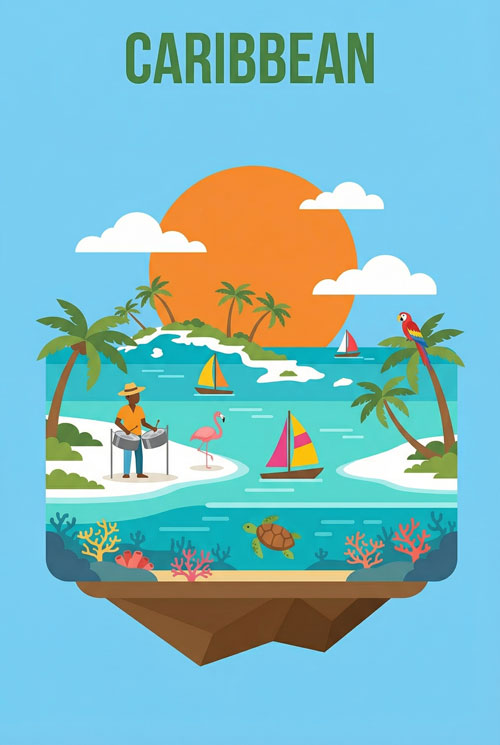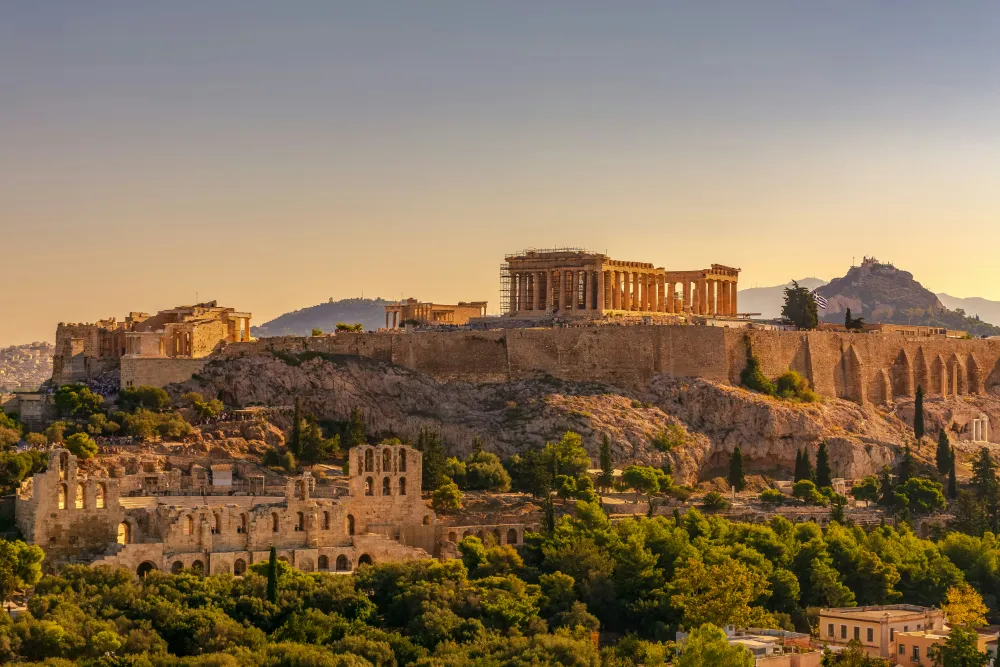eSIM, eSIM Greece
The Best Time to Visit Italy and Greece: A Complete Guide
This guide is designed to be your strategic tool. We’ll break down the seasons, analyze the weather, and demystify the crowds and costs for both countries.
Whether you’re planning an epic two-nation adventure or trying to decide between them, this detailed report will help you pinpoint your perfect travel window, ensuring your Mediterranean dream becomes a flawless reality.
The Short Answer: Italy & Greece At-a-Glance
For those who need a quick answer, here is a snapshot of the best times to travel based on your top priority.
- Best for Ideal Weather & Fewer Crowds (The Sweet Spot): Late Spring (May to early June) and Early Autumn (September to early October). This is the “best of all worlds” window, offering pleasant, warm weather perfect for both sightseeing and beach days, but with fewer crowds and more moderate prices than the summer peak. However, be aware that these shoulder seasons are becoming increasingly popular, with May and September now feeling more “peak-adjacent” than truly off-peak.
- Best for Budget Travelers: The heart of the off-season (November, January, and February). This period offers the absolute lowest prices on flights and accommodations, with potential savings of 20-50% compared to summer.
- Best to Avoid Crowds Entirely: Winter (January and February). If your main goal is to experience iconic sites like the Uffizi Gallery or the Acropolis in relative solitude, these are the quietest months of the year.
- Best for Guaranteed Beach & Swimming Weather: Peak Summer (July and August). For guaranteed hot, sunny days and the warmest sea temperatures, the high summer months are unbeatable. Just be prepared for the trade-offs in crowds and cost.
- Best for Hiking & Outdoor Activities: Spring (April-May) and Autumn (September-October). These seasons provide cooler, more comfortable temperatures that are ideal for physical activities like hiking in the Dolomites, exploring the Cinque Terre trails, or trekking through Crete’s Samaria Gorge.
When to Visit Italy & Greece
An infographic guide to planning your perfect Mediterranean adventure based on weather, crowds, and cost.
The Quick Guide: Your Trip, Your Priority
Best Weather
May-June & Sept-Oct for a perfect balance of sun and comfortable temperatures.
Best for Budget
November, January & February see prices for flights and hotels drop by up to 50%.
Avoid Crowds
Visit in January & February to experience iconic sites in relative solitude.
Best for Beaches
July & August guarantee the hottest days and warmest seas for sun-worshippers.
A Mediterranean Year: The Seasons
Spring (March – May)
A season of awakening. Landscapes are vibrant and green, with wildflowers carpeting the countryside. The weather is ideal for sightseeing without the summer heat, but the sea is still chilly for swimming.
Pros: Fewer crowds, moderate prices, perfect for hiking, rich with Easter festivals.
Cons: Unpredictable rain (especially April), Easter price spikes, some island services still closed in early spring.
Seasonal Climate: Spring
Summer (June – August)
The peak season of sun and energy. Expect hot, dry, and relentless sun, perfect for beach life and island hopping when all services are running. The trade-off is significant crowds and the year’s highest prices.
Pros: Guaranteed beach weather, warm seas, vibrant nightlife, full ferry schedules.
Cons: Intense heat, maximum crowds, highest prices, *Ferragosto* closures in Italy.
Seasonal Climate: Summer
Autumn (September – November)
A gentle transition from the summer frenzy. September continues the summer warmth, while October brings crisp, mild days ideal for exploring. The sea remains warm, and harvest festivals abound.
Pros: Great weather, thinning crowds, lower prices, warm seas, food & wine festivals.
Cons: Increasing chance of rain, coastal resorts begin closing in late Oct, shorter daylight hours.
Seasonal Climate: Autumn
Winter (December – February)
The quietest and most affordable season, offering an intimate perspective. Ideal for city breaks and museum hopping without the hordes, but requires embracing cooler, wetter weather. Islands are mostly shut down.
Pros: Lowest prices, fewest crowds, authentic local feel, Christmas markets & Venice Carnival.
Cons: Cold & rainy weather, many coastal/island businesses closed, limited ferry services.
Seasonal Climate: Winter
The Cost of a Mediterranean Trip
High vs. Low Season Savings
Traveling during the off-season (Nov-Mar) versus the peak season (Jul-Aug) can result in dramatic savings. The chart on the right illustrates the estimated percentage drop in costs, making a winter trip a compelling option for budget-conscious travelers.
40-65%
Flight Savings
50-70%
Hotel Savings
Estimated Cost Comparison
A Year of Celebration: Key Festivals
FEB
Carnival Season
Venice, Italy explodes with masks and costumes. Greece celebrates *Apokries* before Lent.
APR
Easter (*Pasqua/Pascha*)
The most important religious festival in both countries, with profound celebrations nationwide.
JUL/AUG
Peak Summer Festivals
Italy hosts the Palio di Siena, while Greece is alive with island *panigiria* and the Athens & Epidaurus Festival.
SEP/OCT
Harvest Season (*Vendemmia*)
A food lover’s dream. Italy celebrates grape, truffle, and chestnut harvests with local *sagre* (food festivals).
A Deep Dive: Italy & Greece by the Season
Every season paints Italy and Greece in a different light, offering unique experiences, benefits, and challenges. Here’s a detailed breakdown to help you understand the distinct character of each period.
Spring (March, April, May)
Spring is a season of awakening in the Mediterranean. Landscapes are at their most vibrant, and the weather is often perfect for exploration before the intense heat of summer arrives.
Italy in Spring
- Weather: Spring in Italy is characterized by mild and generally pleasant weather, though it can be unpredictable, especially in March and April. Temperatures climb steadily, with northern regions like Milan and Venice remaining cooler and wetter than the south.
By May, much of the country enjoys comfortably warm days, perfect for sightseeing. The countryside, particularly in Tuscany and Umbria, is a spectacular sight, bursting with wildflowers and lush green hills. However, the sea is often still too chilly for comfortable swimming until late May. - Pros: The primary advantage of spring is avoiding the peak summer crowds and prices. It is arguably the best time for active travel, like exploring the ruins of Pompeii or hiking the Amalfi Coast, without battling oppressive heat.
The season is also rich with cultural events, including the nationwide celebrations for Easter (Pasqua) and Liberation Day (April 25), as well as Rome’s birthday on April 21. - Cons: The biggest drawback is the Easter holiday (Pasqua). Holy Week brings a massive surge in tourism, particularly to Rome and the Vatican, causing prices for flights and hotels to spike dramatically. The weather can also be unreliable, with April known for its rain showers, so packing layers and a rain jacket is essential. In mountainous regions like the Dolomites, some higher-altitude trails and cable cars may still be closed due to snow.
Greece in Spring
- Weather: Spring is a glorious time in Greece. After the winter rains, the landscape is incredibly green and carpeted with a spectacular array of wildflowers, making it a paradise for hikers and photographers. Temperatures are mild and comfortable, ideal for exploring ancient sites without the risk of heat exhaustion.
- Pros: Like Italy, spring in Greece means fewer crowds and more moderate prices compared to the summer crush. It’s the perfect time to visit the Acropolis in Athens or the ruins at Delphi when you can wander in relative peace. The most significant cultural event of the year, Greek Orthodox Easter, is a profound experience, with unique celebrations and traditions taking place across the country.
- Cons: The main downside for beach lovers is the sea temperature, which remains quite cold for swimming until well into May.
While the mainland is fully accessible, some tourist-focused businesses on the smaller islands may still be closed or just reopening for the season in March and early April. Ferry services, while operational, are less frequent than in the summer months, requiring more careful planning for island-hopping itineraries.
| Italy Climate Data: Spring Averages | March | April | May |
| Rome (Central) | |||
| Avg. High/Low Temp (°C/°F) | 16/8 (61/46) | 19/11 (66/52) | 24/15 (75/59) |
| Avg. Rainfall (mm) | 67 | 76 | 53 |
| Avg. Daily Sunshine (hrs) | 6 | 7 | 9 |
| Florence (Central) | |||
| Avg. High/Low Temp (°C/°F) | 16/6 (61/43) | 20/9 (68/48) | 25/13 (77/55) |
| Avg. Rainfall (mm) | 64 | 86 | 74 |
| Avg. Daily Sunshine (hrs) | 5 | 6 | 9 |
| Venice (North) | |||
| Avg. High/Low Temp (°C/°F) | 13/5 (55/41) | 17/9 (63/48) | 22/14 (72/57) |
| Avg. Rainfall (mm) | 58 | 70 | 69 |
| Avg. Daily Sunshine (hrs) | 5 | 6 | 7 |
| Palermo (South) | |||
| Avg. High/Low Temp (°C/°F) | 16/11 (61/52) | 18/13 (64/55) | 22/17 (72/63) |
| Avg. Rainfall (mm) | 59 | 44 | 23 |
| Avg. Daily Sunshine (hrs) | 6 | 7 | 9 |
| Greece Climate Data: Spring Averages | March | April | May |
| Athens (Mainland) | |||
| Avg. High/Low Temp (°C/°F) | 16/8 (61/46) | 20/12 (68/54) | 25/16 (77/61) |
| Avg. Rainfall (mm) | 49 | 28 | 24 |
| Avg. Daily Sunshine (hrs) | 6 | 8 | 10 |
| Corfu (Ionian) | |||
| Avg. High/Low Temp (°C/°F) | 16/7 (61/45) | 20/10 (68/50) | 24/14 (75/57) |
| Avg. Rainfall (mm) | 100 | 70 | 41 |
| Avg. Daily Sunshine (hrs) | 6 | 8 | 10 |
| Santorini (Aegean) | |||
| Avg. High/Low Temp (°C/°F) | 16/11 (61/52) | 19/13 (66/55) | 23/17 (73/63) |
| Avg. Rainfall (mm) | 40 | 16 | 11 |
| Avg. Daily Sunshine (hrs) | 9 | 11 | 12 |
| Crete (Aegean) | |||
| Avg. High/Low Temp (°C/°F) | 17/9 (63/48) | 20/12 (68/54) | 24/15 (75/59) |
| Avg. Rainfall (mm) | 62 | 21 | 11 |
| Avg. Daily Sunshine (hrs) | 5 | 6 | 8 |
Summer (June, July, August)
Summer is the season of sun, crowds, and peak energy. It’s the classic time for a Mediterranean holiday, but it comes with significant trade-offs that modern travelers must consider carefully.
Italy in Summer
- Weather: Expect hot, dry, and relentlessly sunny conditions, particularly in central and southern Italy. Temperatures in cities like Rome and Florence frequently climb above 35∘C (95∘F), and recent years have seen an increase in intense heatwaves. The north, including Venice and Milan, can be very humid, with a higher chance of afternoon thunderstorms.
- Pros: This is the best time for a quintessential beach holiday, with long daylight hours and the warmest sea temperatures of the year. The country is buzzing with life and a vibrant atmosphere, hosting famous festivals like the Palio di Siena horse race (July 2 and August 16) and the spectacular Verona Opera Festival, which runs all summer.
- Cons: Summer is the absolute high season, meaning maximum crowds and the highest prices for flights, hotels, and tours. Lines for iconic attractions like the Colosseum, Vatican Museums, and Uffizi Gallery can be hours long, and the heat can make waiting and exploring deeply uncomfortable.
A unique Italian phenomenon is Ferragosto, the public holiday on August 15, which often extends into a nationwide vacation period for Italians. This creates a paradoxical situation: coastal and mountain resorts become incredibly packed and expensive, while many family-run shops and restaurants in big cities shut down completely, leaving a less authentic, tourist-centric feel.
Greece in Summer
- Weather: Summer in Greece is defined by scorching heat and sun. On the mainland, especially in Athens, temperatures regularly soar into the 35−40∘C (95−104∘F) range, making midday sightseeing not just unpleasant but potentially dangerous.
The islands offer some relief, cooled by sea breezes. The Cyclades islands, in particular, experience the Meltemi, strong, dry northern winds that can provide a welcome respite from the heat but can also make some beaches very windy. - Pros: This is prime time for island hopping and beach life. The sea is wonderfully warm, perfect for swimming and watersports. All tourist infrastructure—from the smallest taverna to the most extensive ferry network—is operating at full capacity, making travel between islands easiest during these months. The nightlife on islands like Mykonos and Ios is legendary and at its most vibrant. It’s also the season for major cultural events like the Athens & Epidaurus Festival, which features performances in ancient theaters.
- Cons: The popularity of a Greek summer comes at a cost. The crowds are immense, especially on famous islands like Santorini and Mykonos, which can feel completely overwhelmed. This is, by far, the most expensive time to visit, with prices for flights and hotels increasing by 30-50% or more.
The extreme heat is a serious consideration; in recent years, the Acropolis has had to close during the hottest part of the day to protect visitors. While the Meltemi winds can be refreshing, they can also be powerful enough to occasionally disrupt ferry services.
| Italy Climate Data: Summer Averages | June | July | August |
| Rome (Central) | |||
| Avg. High/Low Temp (°C/°F) | 29/19 (84/66) | 32/21 (90/70) | 32/21 (90/70) |
| Avg. Rainfall (mm) | 34 | 21 | 34 |
| Avg. Daily Sunshine (hrs) | 10 | 11 | 10 |
| Florence (Central) | |||
| Avg. High/Low Temp (°C/°F) | 29/17 (84/63) | 32/19 (90/66) | 32/19 (90/66) |
| Avg. Rainfall (mm) | 55 | 40 | 61 |
| Avg. Daily Sunshine (hrs) | 10 | 11 | 10 |
| Venice (North) | |||
| Avg. High/Low Temp (°C/°F) | 26/18 (79/64) | 29/20 (84/68) | 28/19 (82/66) |
| Avg. Rainfall (mm) | 78 | 64 | 65 |
| Avg. Daily Sunshine (hrs) | 9 | 10 | 9 |
| Palermo (South) | |||
| Avg. High/Low Temp (°C/°F) | 26/21 (79/70) | 29/24 (84/75) | 29/24 (84/75) |
| Avg. Rainfall (mm) | 6 | 3 | 13 |
| Avg. Daily Sunshine (hrs) | 11 | 12 | 11 |
| Greece Climate Data: Summer Averages | June | July | August |
| Athens (Mainland) | |||
| Avg. High/Low Temp (°C/°F) | 30/21 (86/70) | 33/23 (91/73) | 33/23 (91/73) |
| Avg. Rainfall (mm) | 11 | 6 | 5 |
| Avg. Daily Sunshine (hrs) | 11 | 12 | 11.5 |
| Corfu (Ionian) | |||
| Avg. High/Low Temp (°C/°F) | 29/18 (84/64) | 32/20 (90/68) | 33/21 (91/70) |
| Avg. Rainfall (mm) | 14 | 4 | 20 |
| Avg. Daily Sunshine (hrs) | 11 | 12 | 12 |
| Santorini (Aegean) | |||
| Avg. High/Low Temp (°C/°F) | 27/21 (81/70) | 29/23 (84/73) | 29/23 (84/73) |
| Avg. Rainfall (mm) | 0 | 7 | 0 |
| Avg. Daily Sunshine (hrs) | 13 | 14 | 13 |
| Crete (Aegean) | |||
| Avg. High/Low Temp (°C/°F) | 28/20 (82/68) | 31/23 (88/73) | 31/23 (88/73) |
| Avg. Rainfall (mm) | 1 | 1 | 1 |
| Avg. Daily Sunshine (hrs) | 11 | 13 | 12 |
Autumn (September, October, November)
Autumn offers a gentle transition from the summer frenzy, bringing with it pleasant weather, harvest festivals, and a more relaxed atmosphere.
Italy in Autumn
- Weather: September often feels like a continuation of summer, with warm days and seawater that’s perfect for swimming. October brings milder, crisp weather ideal for sightseeing, though the chance of rain begins to increase. November is typically cool and can be one of Italy’s wettest months, particularly in the north and central regions.
- Pros: September and October are fantastic months to visit, striking a perfect balance between pleasant weather and thinning crowds.
This is the season of the vendemmia (grape harvest) and a bounty of food festivals (sagre) celebrating local delicacies like truffles, mushrooms, and chestnuts, especially in regions like Piedmont and Tuscany. Prices for flights and hotels see a welcome drop from their summer highs. - Cons: The primary drawback is the increasing likelihood of rain as the season progresses. Many coastal resorts and tourist-oriented businesses, especially along the Amalfi Coast and in Cinque Terre, may begin to close down for the winter towards the end of October. Daylight hours also grow noticeably shorter, reducing time for exploration.
Greece in Autumn
- Weather: September is often considered one of the best months to visit Greece, offering a perfect combination of sunny days, warm air temperatures, and delightfully warm seas. October remains pleasant, though cooler and with a greater chance of showers. By November, the weather turns decidedly cooler and wetter, signaling the start of winter.
- Pros: This season offers a fantastic blend of good weather, fewer people, and lower prices. The sea, having been warmed all summer, is at its most inviting in September and early October.
It’s an excellent time for sightseeing and hiking, with comfortable temperatures making it a joy to explore ancient ruins and natural landscapes. - Cons: The tourist season on the islands begins to wind down significantly in October. Many hotels, tavernas, and shops will close for the winter, particularly on smaller islands. Ferry schedules also become less frequent, making island hopping more challenging. While the weather is often beautiful, it becomes more unpredictable as autumn progresses, especially in late October and November.
| Italy Climate Data: Autumn Averages | September | October | November |
| Rome (Central) | |||
| Avg. High/Low Temp (°C/°F) | 27/17 (81/63) | 22/13 (72/55) | 17/9 (63/48) |
| Avg. Rainfall (mm) | 73 | 94 | 115 |
| Avg. Daily Sunshine (hrs) | 8 | 6 | 4 |
| Florence (Central) | |||
| Avg. High/Low Temp (°C/°F) | 27/15 (81/59) | 22/11 (72/52) | 15/7 (59/45) |
| Avg. Rainfall (mm) | 78 | 104 | 114 |
| Avg. Daily Sunshine (hrs) | 7 | 5 | 3 |
| Venice (North) | |||
| Avg. High/Low Temp (°C/°F) | 24/15 (75/59) | 18/11 (64/52) | 12/6 (54/43) |
| Avg. Rainfall (mm) | 66 | 87 | 76 |
| Avg. Daily Sunshine (hrs) | 6 | 4 | 3 |
| Palermo (South) | |||
| Avg. High/Low Temp (°C/°F) | 26/21 (79/70) | 23/18 (73/64) | 19/14 (66/57) |
| Avg. Rainfall (mm) | 41 | 98 | 94 |
| Avg. Daily Sunshine (hrs) | 8 | 6 | 5 |
| Greece Climate Data: Autumn Averages | September | October | November |
| Athens (Mainland) | |||
| Avg. High/Low Temp (°C/°F) | 29/19 (84/66) | 24/15 (75/59) | 18/11 (64/52) |
| Avg. Rainfall (mm) | 16 | 28 | 49 |
| Avg. Daily Sunshine (hrs) | 9.5 | 7 | 5 |
| Corfu (Ionian) | |||
| Avg. High/Low Temp (°C/°F) | 28/18 (82/64) | 24/14 (75/57) | 19/10 (66/50) |
| Avg. Rainfall (mm) | 95 | 184 | 237 |
| Avg. Daily Sunshine (hrs) | 10 | 7 | 5 |
| Santorini (Aegean) | |||
| Avg. High/Low Temp (°C/°F) | 26/21 (79/70) | 23/18 (73/64) | 18/14 (64/57) |
| Avg. Rainfall (mm) | 11 | 38 | 59 |
| Avg. Daily Sunshine (hrs) | 11 | 9 | 8 |
| Crete (Aegean) | |||
| Avg. High/Low Temp (°C/°F) | 28/20 (82/68) | 24/17 (75/63) | 20/13 (68/55) |
| Avg. Rainfall (mm) | 10 | 40 | 69 |
| Avg. Daily Sunshine (hrs) | 10 | 6 | 3 |
Winter (December, January, February)
Winter is the quietest and most affordable season, offering a completely different, more intimate perspective on these popular countries, but it requires careful planning and a willingness to embrace cooler weather.
Italy in Winter
- Weather: Winter weather in Italy is a tale of three regions. The north is often cold, damp, and foggy, with reliable snow in the Alps and Dolomites making it a prime ski destination. Central Italy, including Rome and Florence, is cool and can be wet. The south, including Sicily, is significantly milder, though still prone to rain.
- Pros: This is the cheapest time of year to travel, with rock-bottom prices on flights and hotels. It’s also the least crowded season, allowing you to explore world-famous museums and archaeological sites without the hordes.
The festive season brings charming Christmas markets in December, and February hosts the world-renowned Carnival of Venice, a spectacular explosion of masks and costumes. - Cons: The weather is the main drawback. Cold temperatures, increased rainfall, and shorter daylight hours limit the appeal of outdoor activities. Coastal destinations like the Amalfi Coast and Cinque Terre are largely shut down, with many hotels and restaurants closed for the season. Even in cities, some businesses may take a break in January or February after the holiday rush.
Greece in Winter
- Weather: Winter is the low season for a reason: the weather is generally cool and rainy across the country. The mainland can be quite cold, and the northern mountains receive snow, offering some opportunities for skiing.
- Pros: For the budget-conscious traveler focused on the mainland, winter is ideal. Flights to Athens and accommodation in the city are at their absolute cheapest. This is the best time to experience a more authentic side of Greece, interacting primarily with locals. Major archaeological sites and museums on the mainland are wonderfully peaceful and crowd-free.
- Cons: Winter is the worst possible time to visit the Greek islands. The vast majority of hotels, restaurants, and tourist services shut down completely from November to March.
Ferry services are drastically reduced and can be cancelled at the last minute due to bad weather, making island hopping nearly impossible and ill-advised. This is not a beach destination by any stretch.
| Italy Climate Data: Winter Averages | December | January | February |
| Rome (Central) | |||
| Avg. High/Low Temp (°C/°F) | 13/6 (55/43) | 12/4 (54/39) | 13/4 (55/39) |
| Avg. Rainfall (mm) | 111 | 75 | 74 |
| Avg. Daily Sunshine (hrs) | 4 | 4 | 5 |
| Florence (Central) | |||
| Avg. High/Low Temp (°C/°F) | 11/3 (52/37) | 11/2 (52/36) | 12/3 (54/37) |
| Avg. Rainfall (mm) | 91 | 69 | 69 |
| Avg. Daily Sunshine (hrs) | 3 | 4 | 4 |
| Venice (North) | |||
| Avg. High/Low Temp (°C/°F) | 8/1 (46/34) | 7/−1 (45/30) | 9/1 (48/34) |
| Avg. Rainfall (mm) | 58 | 54 | 50 |
| Avg. Daily Sunshine (hrs) | 3 | 3 | 4 |
| Palermo (South) | |||
| Avg. High/Low Temp (°C/°F) | 16/12 (61/54) | 15/11 (59/52) | 15/11 (59/52) |
| Avg. Rainfall (mm) | 92 | 100 | 73 |
| Avg. Daily Sunshine (hrs) | 4 | 4 | 5 |
| Greece Climate Data: Winter Averages | December | January | February |
| Athens (Mainland) | |||
| Avg. High/Low Temp (°C/°F) | 14/8 (57/46) | 13/7 (55/45) | 14/7 (57/45) |
| Avg. Rainfall (mm) | 60 | 53 | 49 |
| Avg. Daily Sunshine (hrs) | 4 | 4 | 5 |
| Corfu (Ionian) | |||
| Avg. High/Low Temp (°C/°F) | 14/6 (57/43) | 13/5 (55/41) | 14/6 (57/43) |
| Avg. Rainfall (mm) | 259 | 196 | 132 |
| Avg. Daily Sunshine (hrs) | 4 | 4 | 5 |
| Santorini (Aegean) | |||
| Avg. High/Low Temp (°C/°F) | 15/11 (59/52) | 14/10 (57/50) | 14/10 (57/50) |
| Avg. Rainfall (mm) | 75 | 71 | 43 |
| Avg. Daily Sunshine (hrs) | 6 | 7 | 7 |
| Crete (Aegean) | |||
| Avg. High/Low Temp (°C/°F) | 16/10 (61/50) | 15/8 (59/46) | 15/8 (59/46) |
| Avg. Rainfall (mm) | 89 | 78 | 64 |
| Avg. Daily Sunshine (hrs) | 3 | 3 | 3 |
Your Perfect Trip: The Best Time by Travel Style
The ideal time for your Mediterranean adventure depends entirely on what you want to do. Here are tailored recommendations based on the most popular travel styles.
For the Sun Worshipper: Best Time for Beaches
If your dream trip involves sun-drenched sands and swimming in turquoise waters, timing is crucial.
- Italy: The prime beach season runs from June to September. For the best balance of warm sea temperatures and slightly fewer people, June and September are the winners.
July and August deliver the most intense heat and guaranteed sunshine but come with a heavy price: beaches, especially on the famous Amalfi Coast and in Cinque Terre, are packed elbow-to-elbow, and renting a sunbed and umbrella can be exorbitantly expensive. While May is beautiful, the sea can still be bracingly cool for swimming. - Greece: The formula is similar. June and September offer a fantastic combination of warm, swimmable seas and a more relaxed atmosphere than the peak months. The sea is actually at its warmest in late August and September, having been heated by the sun all summer.
July and August are the high-energy peak, perfect for those who love a bustling beach scene and vibrant nightlife but challenging for those seeking tranquility. For island hoppers, a key consideration is that the ferry network is most extensive and frequent from June through September, simplifying logistics.
For the Explorer: Best Time for Sightseeing & Ancient Ruins
To truly appreciate the millennia of history etched into the landscapes of Italy and Greece, visiting when you can walk for hours in comfort is key.
- Italy: The shoulder seasons of April-May and September-October are unquestionably the best for exploring Italy’s vast open-air museum. The weather is mild and pleasant, making it a joy to wander through the Roman Forum, get lost in the alleys of Venice, or explore the excavated streets of Pompeii.
During these months, the crowds at major sites are noticeably smaller than in summer, and queues are more manageable. While winter offers the most solitude, it comes with the trade-off of potentially cold, rainy weather and shorter opening hours for some attractions. - Greece: The same logic applies. The shoulder seasons are ideal for visiting iconic sites like the Acropolis in Athens, the oracle at Delphi, or the ancient stadium at Olympia. The intense summer heat makes exploring these exposed, shadeless sites not only uncomfortable but potentially hazardous.
A pro tip for popular sites like the Acropolis, even in the shoulder season, is to visit either first thing in the morning (at opening time) or late in the afternoon to avoid the midday crush of tour groups and cruise ship passengers.
A critical update for planning: Greece implemented a new ticketing policy in 2025 that abolished the 50% winter discount for archaeological sites. Ticket prices are now fixed year-round and are tiered based on the site’s popularity. This means a winter visit to the Acropolis (€30) now costs the same as a summer visit, a significant change for budget travelers who previously relied on off-season discounts.
For the Hiker: Best Time for Outdoor Adventures
From Alpine peaks to coastal paths, the best time for hiking varies dramatically by region.
- Italy:
- The Dolomites & Italian Alps: The hiking season is relatively short, running from late June to September. This is when the high-altitude trails are generally free of snow and the mountain huts (rifugi) are open. July and August can bring afternoon thunderstorms, so an early start is always wise.
- Cinque Terre, Amalfi Coast & Tuscany: The best times are Spring (April-May) and Autumn (September-October). The summer months are simply too hot for enjoyable trekking. Be aware that the popular “Blue Trail” in Cinque Terre requires the purchase of a Cinque Terre Trekking Card and can get extremely congested, especially on holidays like May 1st. For more solitude, explore the higher, free trails above the villages.
- Greece:
- Mainland & Islands: The prime hiking seasons are Spring (March-May) and Autumn (October-November). Spring is particularly beautiful, with the landscape covered in green grass and colorful wildflowers. Autumn offers cooler temperatures and the changing colors of the foliage. Summer hiking should be avoided due to dangerously high temperatures.
- Crete’s Samaria Gorge: This world-famous trek has a specific season. It typically opens to the public on May 1st and closes at the end of October, weather permitting.
For the Budget Traveler: The Cheapest Time to Go
If stretching your euros or dollars is the top priority, traveling in the off-season offers dramatic savings.
- The Cheapest Months: For both Italy and Greece, the most affordable time to travel is during the low season, from November to March (excluding the Christmas and New Year’s holiday period). January and February are typically the absolute cheapest months.
- What to Expect: During this period, you can find flights and hotels for 20-50% less than in the peak of summer. Cities like Rome, Florence, and Athens will be much quieter, allowing for a more relaxed experience at a lower cost.
However, this budget-friendly window comes with caveats. The weather will be colder and wetter, and many businesses in coastal and island destinations will be closed. As noted, Greece has also eliminated its winter ticket discounts for major sites, slightly increasing the cost of off-season sightseeing compared to previous years.
| At-a-Glance Cost Comparison: High vs. Low Season | Peak Season (July/Aug) | Off-Season (Jan/Feb) | Estimated Savings |
| Flight from USA (Round-trip) | $1,200 – $2,500+ | $600 – $900 | 40-65% |
| Mid-Range Hotel (Per Night) | $200 – $500+ | $80 – $150 | 50-70% |
| Guided Tour (Per Person) | $80 – $150+ | $60 – $120 | 20-30% |
For the Culture Vulture: Best Time for Festivals
Planning your trip around a unique festival can transform a great vacation into an unforgettable one. Both countries have a calendar packed with vibrant events.
- Italy’s Festival Highlights: Italy’s calendar is a mix of spectacular public displays and deeply traditional food festivals (sagre). The sagre, often held in autumn, celebrate the harvest of a specific local product and offer an incredible, authentic taste of Italian culture away from the main tourist trail.
- Greece’s Festival Highlights: Greece’s major events are deeply tied to the Orthodox calendar and national history. The most important celebration of the year is Easter, which is a profound cultural experience.
In summer, the islands come alive with panigiria, local saints’ day festivals featuring food, wine, and traditional music and dancing that last late into the night—a fantastic way to experience authentic island life.
| Major Festivals & Holidays Calendar 2025 |
| Month |
| January |
| February |
| March |
| April |
| May |
| June |
| July |
| August |
| September |
| October |
| November |
| December |
For the Family: Best Time for Traveling with Kids
Traveling with children often means being tied to school holiday schedules, which unfortunately coincides with the peak summer season in both Italy and Greece. While this presents challenges, a successful family trip is entirely possible with smart planning.
- The Challenge: July and August mean intense heat, huge crowds, and the highest prices of the year. These factors can be particularly tough on younger travelers.
- The Strategy:
- Book Far in Advance: To secure family-friendly accommodation and reasonable flight prices, booking many months ahead is essential.
- Choose Your Location Wisely: Instead of heading to the most famous (and crowded) spots, consider alternatives. In Italy, the beaches of Puglia or the countryside of Umbria can be more relaxed than the Amalfi Coast. In Greece, consider a larger, family-friendly island like Naxos or Crete over the intense crowds of Santorini or Mykonos.
- Pace Yourselves: Don’t try to cram too much in. Adopt the local rhythm by exploring in the morning, taking a long midday break (riposo in Italy) to escape the heat, and heading out again in the late afternoon and evening.
- The Sweet Spot: If you have any flexibility, early June is an excellent compromise. The school year is ending, the weather is warm and sunny but not yet oppressively hot, the sea is swimmable, and the peak crowds of July and August have not yet arrived.
Stay Connected in Italy and Greece with an eSIM
In today’s world, staying connected while traveling is no longer a luxury—it’s a necessity. Having reliable data on your phone the moment you land is crucial for navigating with maps, booking a ride-share, looking up museum hours, translating a menu, or making last-minute hotel reservations.
For years, travelers faced a frustrating choice: either pay exorbitant international roaming fees to their home provider or waste precious vacation time hunting down a local SIM card.
The problem with roaming is the shock that comes with the bill. Major carriers often charge daily fees that can add up to hundreds of dollars over a trip, often for limited amounts of high-speed data.
The alternative, buying a physical SIM card, presents its own set of hassles. You’ll need to find a store at the airport (where prices are often inflated) or in the city, wait in line, and go through a registration process that, in both Italy and Greece, legally requires you to present your passport. Sometimes, activation isn’t even immediate, leaving you disconnected when you need it most.
This is where the modern solution comes in: the eSIM. An eSIM (or embedded SIM) is a digital SIM card that you can download to your compatible smartphone before you even leave home. It offers the ultimate in convenience, affordability, and ease of use.
With an eSIM from eSIM4.com, you can download a data plan for Italy and Greece before you even leave home and activate it the moment you land. No more bill shock, no more airport SIM queues. You get instant, high-speed data at a clear, prepaid price, allowing you to start your adventure seamlessly.
Check out eSIM4.com for affordable, reliable data plans for your trip to Italy and Greece.
Click Here For Italy eSIM Plans
Click Here For Greece eSIM Plans













